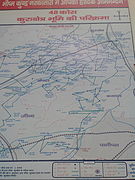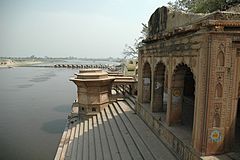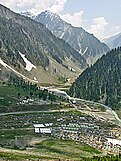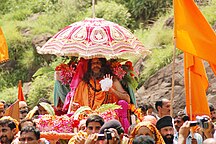Yatra
This article needs additional citations for verification. (December 2023) |

Yatra (
A tīrtha-yātrā is a
In present times, yatras are highly organized affairs, with specialized tourism companies catering to yatris. State governments are sometimes involved in the organization of annual yatras, stipulating numbers, registering yatris, and regulating yatri traffic.
There are numerous pilgrimage sites in India[9] and elsewhere.
Types of yatras
In order of importance, in India there are 7
Holiest cities: Sapta Puri are Ayodhya, Mathura, Haridwar, Varanasi, Kanchipuram, Ujjain and Dwarka.[10] Kurukshetra, includes Jyotisar where Bhagavad Gita was revealed,[11] is another holy city.
Holy rivers: The
Holy mountains: such as Mount Kailash,[13] Badrinath, Kedarnath, Gangotri, and Yamunotri, Sarasvatotri, etc.
Holy
- Sacred river circuit: Yatra to and Sarasvati, Narmada, etc.
Holy Fairs and
Holy Temples: Examples are the
Holy processions: 'Yatra' can also be described as a procession, or any festival which figures a procession, such as
Holy Deities: Kuladaivat Hindu families have their own family patron deity.[21] This deity is common to a lineage, a clan or a locality.
Important national pilgrimage circuits of Indic-religions
A yatra or pilgrimage across a much larger area covering multiple faraway cities or sites, related to a specific deity or theme, are called the "circuit". Three most important Hindu-Buddhist "Rahtriya yatra" (national pilgrimage circuit) are related to the important figures such as Rama, Krishna, Buddha, and Guru Nanak, where they had personally visited are as follows.
- Hindu circuit, many of which are also related to greatest Hindu empires and dynasties.
- Fairs & festivals
- Kumbh Mela
- Barahachhetra– a semi-Kumbh Mela in Sunsari Nepal
- Mahamaham – the Tamil Kumbh Mela
- Gita Mahotsav
- Maghi – a Sikh festival recognised by Guru Amar Das
- Pushkaram – the river festivals of Karnataka, Andhra Pradesh and Telangana
- Pushkar Fair – the springtime fair in Rajasthan, includes the tradition of a dip in the Pushkar lake
- Kumbh Mela
- (place of death of Krishna).
- Rama circuit - Ram Van Gaman Path:
This prikarma entails Ayodhya, Chitrakoot, Hampi and Rameswaram. - Sapta Puri, 7 holiest Hindu cities in India viz. Ayodhya, Mathura, Haridwar, Varanasi, Kanchipuram, Ujjain, Dwarka.
- Shakti Pithas
- Shiva circuits
- Char Dham, holiest pilgrimage circuit of 4 sites viz. Badrinath, Dwaraka, Puri and Rameswaram.
- Chota Char Dham, smaller pilgrimage circuit of 4 sites in Uttarakhand viz. Yamunotri, Gangotri, Kedarnath, and Badrinath.
- Maha Jyotirlinga, 12 holiest Shiva lingam temples in India.
- Mount Kailash and Lake Manasarovar yatra circuit.
- Fairs & festivals
- Buddha circuit:
These prikarma entails the following:- places Lord Buddha stayed,
- Rajgir hills, Kurukshetra (Bodh Stupa on bank of Brahma Sarovar, pilgrimage undertaken by Buddha), Shrughna (Yamunanagar, vihara visited by Buddha for sermon), Adi Badri (saraswati udgam sthal and vihara visited by Buddha), Parinirvana Stupa (place of death and nirvana of Buddha at Kushinagar, and Sankissa.
- Japan has but many Buddhism related pilgrim yatras, such as Shikoku Pilgrimage, eighty-eight temples pilgrimage in the Shikoku island, Japan 100 Kannon Pilgrimage.
- Jain circuit:
- Many of the Jain tirthas are related to the Tirthankara, or
- they are among the newly constructed largest jain temples.
- Sikh circuit:
This prikarma entails the following:- Panj Takht, namely Golden Temple, Takht Sri Patna Sahib, Nanded Hazur Sahib, Takht Sri Damdama Sahib Bhatinda, and Anandpur Sahib.
- Guru Nanak's birth and death places at Gurdwara Janam Asthan and Kartarpur Corridor (both in Pakistan), his travels called udasi.
- Martyrs's places at Gurudwara Sis Ganj Sahib and Fatehgarh Sahib of martyrdom of Guru Tegh Bahadurand children of Guru Gobind Singh respectively by Muslim rulers for refusing to convert to Islam.
- Place of pilgrims by Sikh Gurus: Kurukshetra, Kapal Mochan, Paonta Sahib, etc.
- Capitals of important Sikh states: Banda Bahadurin Yamunanagar).
- Fateh Burj at Chapar Chiri where Banda bahadur defeated mughals in Battle of Chappar Chiri and avenged murder of Sikh gurus and their children.
Famous yatras
48 kos parikrama of Kurukshetra

84 Kosi parikrama
The 84-Kosi Yatra is a tradition in Hindu religion that has been there for thousands of years with the belief that it gives deliverance to the performer from the cycle of 84-Lakh Yonis (the cycle of birth and death). According to Hindu belief, the king of Ayodhya performed the "yagna" in the "treta period" at a place in Makhurha in Basti district of Uttar Pradesh which included circumnavigating the six districts in the region. Some religious leaders believe that the right place to start the parikrama should be Basti instead of Ayodhya. According to some, the dates for 84-Kosi Yatra are fixed and takes place in the month of Chaitra.
Mithila Madhya Parikrama
Mithila Madhya Parikrama is an annual fifteen days journey of the central part of ancient Mithila. It is the ancient circular circuit of the capital city of Mithila. In Treta Yuga, Lord Rama and Princess Sita took a circle journey of the capital of Mithila after their marriage in the court of King Janaka in Mithila. This Yatra is held every year in the month of Falgun in Hindu calendar.
Amarnath Yatra

The Amarnath Temple in Jammu and Kashmir is dedicated to Shiva, one of the trinity of gods. The temple is on Amarnath Peak, and is among the most famous shrines in Hinduism. Every year inside the main Amarnath cave an ice Shiva lingam forms, along with two other ice formations representing Ganesha and Parvati. Amarnath yatra is held every year to pay homage to Shiva and Parvati. The temple is a very popular yatra destination for Hindus; about four lakh people visit during the season.
Brij Yatra

Vraja Parikrama circuit of pilgrimage was formally established by the 16th century sadhus of vaishnava sampradaya with fixed routes, itinerary and rituals. The circuit covers is spread across 2500 km2 area with 84 kos or 300 km long periphery extending 10 km to east and 50 km to north and west. Braj has two main types of pilgrimage circuits, the traditional longer "Braj Yatra" encompassing the whole circuit, and the other shorter significantly modified contemporary point-to-point pilgrimage to visit the main sites at Mathura, Vrindavan, Gokul, Govardhan. The former, longer traditional pilgrimage route, also includes additional sacred sites Nandgaon and Barsana with travel on foot.[30]
Char Dham Yatra
The
Deoghar Yatra
Kailash-Mansarovar Yatra
Kanwar Yatra
The Kanwar Yatra is an annual pilgrimage of devotees of Shiva, known as Kānwarias, to Hindu pilgrimage places of Haridwar, Gaumukh and Gangotri in Uttarakhand and Sultanganj in Bihar to fetch holy waters of Ganges River. Millions of participants gather sacred water from the Ganga and carry it across hundreds of miles to dispense as offerings in their local Śhiva shrines, or specific temples such as Pura Mahadeva and Augharnath temple in Meerut, and Kashi Vishwanath, Baidyanath, and Deoghar in Jharkhand.[31]
Kashi yatra
At Kashi Yatra, it is customary for every Hindu to undergo Kashi yatra on barefoot. Pilgrims also visit Gaya to do Gaya Shraddha to their ancestors. Details regarding how to perform various rituals, the greatness of Kashi Kshetra.[32] Importance of Kashi yatra is said in Kasi-Khand of Skanda Purana.[clarification needed]
Pandharpur yatra of Maharashtra
Ratha Yatra
Among the
The Festival of Chariots of
Gallery
-
Amarnath Yatra Camp.
-
Buddha Amarnath Yatra procession, Poonch
See also
- Hindu pilgrimage sites in India
- List of Hindu festivals
- Padayatra
- Parikrama
- Religious tourism in India
- Tirtha and Kshetra
References
- ^ "Pada Yatra: Foot Pilgrimage from Jaffna to Kataragama". padayatra.org. Archived from the original on 2021-10-15. Retrieved 2021-10-03.
- ISBN 0-19-513798-1.
- ISBN 0-415-35445-5.
- ISBN 1-898723-60-5.
- ^ ISBN 978-0-8239-3179-8.
- ^ "Amarnath Yatra". Office of Divisional Commissioner, Jammu and Kashmir Government. Archived from the original on 2007-10-19.
- ISBN 81-7387-089-6.
- ^ "SPOTLIGHT: The long walk for worship". Frontline. Vol. 21, no. 17. August 14–27, 2004. Archived from the original on 2010-08-06.
{{cite magazine}}: CS1 maint: unfit URL (link) - ^ "List of Pilgrimage Sites in India". culturalindia.net. Archived from the original on 2021-10-03. Retrieved 2021-10-03.
- ^ "Dwarka: Built 10,000 Years Ago, The Holiest City Of India Lies Submerged Underwater". Flynote Blog. Archived from the original on 2021-10-03. Retrieved 2021-10-03.
- ^ Syman, Stefanie (2007-10-01). "The First Book of Yoga: The Enduring Influence of the Bhagavad Gita". Yoga Journal. Archived from the original on 2021-10-03. Retrieved 2021-10-03.
- ^ "Narmada water". Vedic Vaani. Archived from the original on 2021-10-03. Retrieved 2021-10-03.
- ^ Sengar, Resham (Nov 8, 2019). "Mount Kailash facts: mindboggling things you may not know about Shiva's home". The Times of India. Archived from the original on 2021-08-05. Retrieved 2021-10-03.
- ^ "Char Dham Yatra 2021 - Chardham Yatra Travel Guide 2021 - Char Dham Yatra Tour". sacredyatra.com. Archived from the original on 2021-09-19. Retrieved 2021-10-03.
- ^ ANI (2017-07-27). ""Sacred" Rameswaram gave India one of its most famous sons: PM Modi". Business Standard India. Archived from the original on 2021-10-03. Retrieved 2021-10-03.
- ^ "Maha Kumbh 2021 - Haridwar Kumbh Mela 2021 India". kumbhamela.net. Archived from the original on 2021-10-03. Retrieved 2021-10-03.
- ^ "SHRI MATA VAISHNO DEVI SHRINE BOARD | Official Website". maavaishnodevi.org. Archived from the original on 2019-08-16. Retrieved 2021-10-03.
- ^ "Jal Adhikar Yatra Takes Off". The South Asian. September 10, 2006. Archived from the original on Aug 29, 2008. Retrieved February 26, 2008.
- ^ "'Save Noyyal Yatra' draws good crowd". The Hindu Business Line. October 3, 2005. Archived from the original on 2009-06-07. Retrieved 2008-02-26.
- ^ "India's rally for Right to Education - Shiksha Adhikar Yatra". Global Call to Action Against Poverty. July 3, 2007. Archived from the original on July 19, 2008.
- ^ "Frequently Asked Questions on Kuladev and Kuldevi". Hindu Janajagruti Samiti. Archived from the original on 2021-10-03. Retrieved 2021-10-03.
- ^ Yogananda, Paramahansa (1997). Autobiography of a Yogi, 1997 Anniversary Edition p. 383. Self-Realization Fellowship (Founded by Yogananda) http://www.yogananda-srf.org/ Archived 2020-12-18 at the Wayback Machine,
- ^ "Kurukshetra map". kurukshetra.nic.in. Archived from the original on 25 June 2016. Retrieved 24 July 2016.
- ^ "Haryana Tourism". Archived from the original on 10 August 2016. Retrieved 24 July 2016.
- ^ "Development of all pilgrimage sites located within a radius of 48 kos (miles) of Kurukshetra would be carried out". Chief Minister's Office, Haryana. 11 October 2015. Archived from the original on 27 July 2016. Retrieved 24 July 2016.
- ^ "The 48 Kos Kurukshetra Region". harekrsna.com. Archived from the original on 27 July 2016. Retrieved 24 July 2016.
- ^ Jyotisar Archived 2018-04-19 at the Wayback Machine Kurukshetra district website.
- Haryana Tourism Corporation Limited. Archivedfrom the original on 2017-02-15. Retrieved 2014-08-08.
- ^ "Tirath in Kurukshetra - Sannehit Sarovar". Kurukshetra district website. Archived from the original on 2014-08-06. Retrieved 2014-08-08.
- ^ Janet Cochrane, 2008, Asian Tourism: Growth and Change Archived 2023-04-07 at the Wayback Machine, page 249.
- ^ Singh, Vikash (2017). Uprising of the Fools. Stanford University Press.
- ^ "Kumbh Mela Diaries: Varanasi". Archived from the original on 2019-08-01. Retrieved 2019-08-01.
External links
Spiritual Yatra Packages


